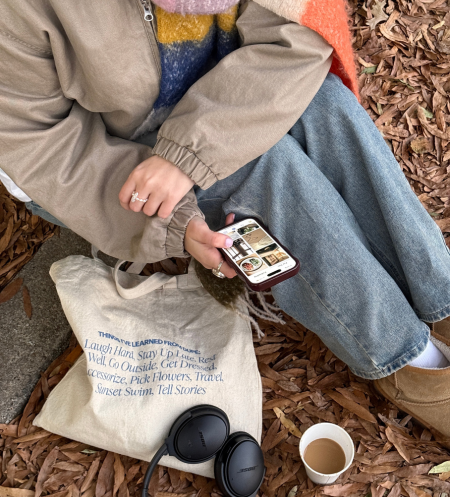
They weren’t lying when they said communication is HARD. If you’re struggling with communicating with compassion, listening with empathy, how to communicate without arguing, or just how to become a better communicator all together, keep reading.
We learn speech. We learn grammar. We learn nonsense vocabulary for the SATs, but we’re never actually taught how to effectively communicate. I just really want to believe that communicating with compassion is more important than learning what Mawkish means.
But instead of learning how to become a better communicator, we’re taught how to communicate from our parents and adults - who often weren’t even taught the correct ways to communicate themselves! Then perpetuating unhealthy communication dynamics.

I’ve known for a while that my communication skills could use some work, but lately I’ve been reallllyyyyyy struggling with compassion and empathy.
I’ve been noticing myself judging and being critical when someone is going through something challenging, as opposed to understanding what they're experiencing.
This has shown up in my relationship countless times where my partner has expressed frustrations about different situations, and instead of responding with compassion, I’ve lashed out with “GOSH it’s not even a big deal”. Ugh.
It’s been hard to accept that I’m not as compassionate as I thought, and that I’ve been acting out of alignment with my authentic self. My authentic self is soft and understanding and loving and caring. But the Adreanna that has been showing up in conversations is judgmental, critical, harsh, and basically, a really big bitch.
I’ve been searching for a way to be more compassionate, and read a highly recommended book called Nonviolent Communication by Marshall Rosenberg. With his tips, I’ve been able to not only practice being more compassionate, but also how to communicate with empathy. It’s been transformational!
Read below to find out what nonviolent communication is, why it relates to compassionate communication, why communicating with compassion is important in relationships, and the 4 steps to communicate with compassion.
What is nonviolent communication
Nonviolent communication (NVC) was developed by psychologist Marshall Rosenberg and is founded on language and communication skills that strengthen our ability to remain human, even under trying conditions.
Thank you for the definition, Merriam-Webster, but wtf does that mean?
When we’re triggered, we often act in ways that are out of alignment with our authentic self. We may want to be gentle, soft, and compassionate, but instead, we judge, yell, and criticize.
Here’s a personal example: when I’m frustrated or angry, I get immensely cold, distant and passive aggressive which is incredibly disrespectful to the person on the receiving end. But with NVC, resistance, defensiveness and intense reactions are reduced and I’m able to foster respect, attentiveness, empathy and compassion.
Instead of habitual, automatic reactions, your words are intensional with nonviolent communication. You are led to express yourself with honesty and clarity, while simultaneously listening to others with respect and empathy. This allows you to meet your own needs, while still communicating with compassion and empathy.
Nonviolent communication does that by focusing on 3 aspects of communication
- Self empathy - the awareness of your own emotions
- Empathy - understanding others with your heart
- Honest self expression - expressing your needs with compassion
NVC trains you to observe your own deeper needs and the needs of others carefully, and to be able to specify behaviors and conditions that are affecting you. You learn to identify and clearly articulate what you are wanting in any given situation. It guides you in reframing how you express yourself and hear others.
The purpose of nonviolent communication is that it helps you connect with others in a way that makes communicating with compassion natural. NVC is a way to resolve differences peacefully by listening empathetically and communicating honestly from the heart.
Communicating with compassion is important in a relationship
Do you ever wonder how to communicate without arguing? Welp. Communicating with compassion is your answer.
Compassionate communication is so important in a relationship.
And I KNOW, you’ve heard this so many times and are like what does that even MEAN?
It’s funny because 9 times out of 10 when asked what the number one factor of a healthy relationship is, people will say communication. But they never explain how and why?!?!?!
Without compassionate communication, we are bound to express ourselves in a way that includes judgment, yelling, and criticism. Conversations end up being a back and forth of
“WELL THAT’S WHAT YOU SAID”
“NO I DIDN’T”
“YES YOU DID”
“WELL, THAT’S NOT WHAT I MEANT”

The conversation ends up going in circles leaving everyone feeling hurt, unheard, unseen, and the worst part, with no resolution. If it goes unresolved, shame, resentment, and tension starts to grow.
We all have needs, and we all deserve to have our needs respected. That goes for you, as well as, the person on the receiving end who you want to criticize for not meeting your needs. The minute you start to judge, yell, and criticize, you start to disrespect the other and neglect their own needs.
With the skills taught with nonviolent communication, you can communicate with compassion. You can assert your feelings and needs while still having empathy for the experience the person on the receiving end is having. You can hold space for yourself, while holding space for the other person as well. When you do this, everything you say comes from the heart, instead of your own hurt.
When we give from the heart, we do so because of how good it feels when we willingly enrich another person’s life. This kind of giving benefits both the giver and the receiver. The receiver enjoys not having to worry about anything that is said out of fear, guilt, shame, or desire for gain. The giver benefits from the enhanced self-esteem that results when they see their efforts contributing to someone’s well-being.
We’ve all been there. Someone doing something only because we’ve badgered them over and over again. And we followed it up with a “I don’t want to tell you to do it, I want you to want to do it”.
This is often the result of guilting and shaming someone into meeting your needs. If you can approach requesting your needs be met with compassionate communication, there is a much higher chance that they will get met. The person on the other end will want to meet your request as opposed to doing it out of guilt and shame, which then breeds resentment.
Getting your needs met is important in a relationship. But that should happen as the result of our honest, and compassionate request, not a demand, criticism, and disrespect. Nonviolent communication will help get you and others’ needs met while eliminating resentment, guilt, and shame, which is unhealthy to carry in a relationship.
4 steps to communicating with compassion
First, observe what is actually happening in a situation: what are you observing others saying or doing that is either enriching or not enriching your life? The trick is to be able to articulate this observation without introducing any judgment or evaluation—to simply say what people are doing that you either like or don’t like.
Next, state how you feel when you observe this action: are you hurt, scared, joyful, amused, irritated?
Thirdly, connect your needs to the feelings you have identified.
Lastly, make a request based on your feelings and needs.
This goes for speaking AND listening. You connect with others by first sensing what they are observing, feeling, and needing; then you discover what would enrich their lives by receiving their request.
Let’s dive in deeper to these steps.

Step 1 | Separate your observation from evaluation
When you are triggered, observe the concrete actions that affect your sense of well-being without evaluating or judging those actions.
Clearly observe what you are seeing or hearing that is affecting you, and DON’T mix in any evaluation. Separate your observation from your evaluation.
When we mix observation with evaluation, people are bound to hear criticism and refuse what we are saying.
This was the most transformational step for me! I had no idea how often I was evaluating and then judging based on my evaluation and THEN communicating based on my judgment. No wonder why so many things that were coming out of my mouth were critical! *EYE ROLL
This can be super challenging at first, but it’s so crucial in order to communicate with compassion because communicating an evaluation will make the receiver feel judged and criticized, and it’s only natural for their response to be defensive. And once they get defensive, it’s not only going to be more challenging to get them to listen to what you have to say, but you are more likely to get defensive back. Thus, starting the cycle of unhealthy, and non-compassionate communication that we don’t want.
Here are some examples of how an observation (O) looks different than an evaluation (E).
E: Rob works too much.
O: Rob spent 60 hours in the office last week
E: Jenn procrastinates.
O: Jenn only studies for exams the night before.
E: She won’t get the project done.
O: I don’t think she’ll get the project done.
E: Jake is too aggressive.
O: Jake hit his brother when he changed the TV channel.
E: You never answer my calls.
O: You didn’t answer my last 2 calls.
E: Hank sucks at soccer.
O: Hank hasn’t scored a goal in 20 games.
Quick tip: Evaluations often use the words always, never, ever, whenever. So if you hear yourself or someone else saying it, you know that an evaluation is present.
Step 2 | Identify and express your feelings
Step 2 is to express how you feel in relation to what you observe. What are your emotions without thoughts or stories attached to them?
This is really difficult for a lot of us because we weren’t taught how to feel and express our emotions. We were often taught to be “other-oriented” where we are more concerned about how what we say and do would affect other people, or how other people would view us.
Since we’re not really good at expressing our feelings, we often think we are expressing our emotions because we use the words “I feel like”. But the use of the word feel isn’t often actually followed by a feeling.
“I feel like you’re ignoring me.”
“I feel like you don’t understand.”
“I feel like you’re overreacting.”
We’re saying “I feel like”, but nothing that follows is a feeling. Instead, we’re saying what we think. If these sentences were communicating feelings, they may read:
“I feel ignored when you don’t answer my text.”
“I feel rejected when I have to repeat myself.”
“I feel threatened when you yell.”
Feelings are not being clearly expressed when…
- the word feel is followed by words like that, like, as if
- the pronouns I, you, he, she, they, it
- names or nouns referring to people
We need to learn how to distinguish our feelings from our thoughts, as well as distinguish between what we feel and how we think others react or behave towards us.
To improve this skill, practice identifying your feelings and putting words to them. Words like good and bad are too vague. Good can mean that you’re feeling happy, excited, relieved, or numerous other emotions. Similarly, bad can mean you're feeling angry, anxious, or confused – all of which are very different emotions.
Building up your vocabulary of emotions will help you increase your ability to clearly articulate what you’re feeling. And, being more specific in identifying your emotions allows you to connect more easily with yourself and others.
Do you have a hard time identifying emotions? Do you wish you had a long list so you can choose from? Me too!
Step 3 | Identify your needs
Now that you identified your feelings, the next step is to acknowledge the root (the needs, values, desires, etc) that created your feelings.
What do you desire to feel a sense of well-being without thinking of a strategy to get there?
In this step, you have to accept responsibility for what you do to generate your own feelings. Understand that what others say and do may be what stirs up your feelings, but it’s never the cause of your feelings.
This is important: Your feelings are a result of how you choose to receive what others say and do, as well as from your particular needs and expectations in that moment.
When someone says something that you perceive in a negative way, you have 4 options on how to receive it.
- You can take it personally by hearing blame and criticism
- You can blame the speaker
- You can turn inward and reflect on your own feelings and needs
- You can reflect on the other person’s feelings and needs as they are currently expressed
It is your choice on which one of the above you choose to do.
This is an important lesson to learn. No one can control you or your feelings. Your feelings are controlled by how you choose to perceive a certain situation, and you have 4 options on how you can choose to receive it.
Look at the difference in responses in these examples.
A: You disappointed me by not calling me last night.
B: I was disappointed when you didn’t call me last night because I wanted to talk over some things that were bothering me.
Here’s another
A: Them backing out of the contract really irritated me.
B: When they backed out of the contract, I felt really irritated because I was counting on that money when I was planning out my expenses for the month.
In both examples, speaker A blames her irritation solely on the behavior of the other person, while Speaker B accepts responsibility for her feelings by acknowledging the thought behind it.
You have to accept responsibility for your feelings, rather than blame others. And you do that by acknowledging your own needs, desires, expectations, values, or thoughts - the purpose of this step.
Once you identify how you feel in step 2, you can connect that emotion to a need in step 3.
If you are disappointed someone isn’t being responsive with you, what do you need instead?
We should identify our needs without thinking of a strategy to get there. This means that you have to identify your need without being controlling in how it gets met.
Here’s an example. You’re frustrated because you think a coworker isn’t including you in communications frequently enough and that’s causing you to feel isolated. You identify that your need is respect - and you feel neglected when he doesn’t involve you. Thinking of a strategy to get your need met would be telling him that he needs to call you every single day after work to loop you in.
Yes, this may get your need met. But it is more of a demand than a request (more on this in step 4). Instead, simply identify the need, which in this example would be “I need to feel more respected”.

Step 4 | Make a request of the other person based on your need
Step 4 is about the concrete actions we request of others in order to enrich our lives and fulfill our needs.
You identified your feelings in step 2 and your need that isn’t being fulfilled in step 3. Step 4 is about asking for something to be done that will fulfill your need from step 3. What specific action would you like to ask for without demanding it?
You need to express your request directly. When you express your needs indirectly, the person on the receiving end is likely to hear criticism which will lead to self-defense or a counterattack. If you wish for a compassionate response, you need to directly communicate in a way that connects your feelings to your needs. This is why nailing step 2 and 3 is crucial.
You must express your feeling with your request. When you express just your feelings, it may not be clear to the listener what you want them to do. Simultaneously, when you make a request without your feelings and needs, the request may sound like a demand. It’s so important that you learn how to connect your feelings with a need, and then express both of them when you are requesting something from others.
Also, communicating your needs more directly requires you to use positive language when making a request as opposed to what you don’t want. Wording your needs in the negative is more likely to provoke resistance from the other person.
And, again, saying what you don’t want is indirect. You need to let the other person know exactly what you want from them so there is no guessing. Remember, people aren’t mind readers. If you want your need to be met, your best chance is communicating exactly what you want.
Here are some examples of indirect requests (I) and how they could be phrased to be more direct (D):
I: I’d like you to be honest with me about yesterday’s meeting.
D: I want you to tell me how you feel about what I did and what you’d like me to do differently.
I: I’d like you to feel more confident in yourself.
D: I’d like you to take a course in assertiveness training, which I believe would increase your self-confidence.
I: I’d like for you to show respect for my privacy.
D: I’d like you to agree to knock before you enter my office.
Make sure what you say is a request and not a demand. Requests are received as demands when listeners believe that they will be blamed or punished if they do not comply. Demands will cause the other person to have two options: to submit or to rebel.
You can demonstrate that you are making a request rather than a demand by how you respond when others don’t comply with your request. If you are prepared to show an empathic understanding of what prevents someone from doing as you asked, then you have made a request, not a demand.
When deciphering if you’re making a request instead of a demand, it’s helpful to scan your mind for the sort of thoughts that automatically transform requests into demands:
He should home at this time.
She’s supposed to answer my call.
I deserve to get a promotion.
I’m justified in having them stay over later.
I have a right to know what they’re talking about.
Words like should, supposed to, justified, and right imply that what request comes out of the situation may be a demand.
Here’s a tip: Sometimes the message you send isn’t always the message that’s received. Therefore, you need to learn how to find out if your message has been accurately heard. To make sure the message you sent is the message that’s received, ask the listener to reflect it back.
I was looking to improve my communication skills and to be more compassionate separately, but I’ve been able tackle both with Non-Violent Communication.
By using the steps above when I’m listening to other’s speak, I’ve been able to connect with them more deeper. I’m now listening for their feelings, needs, and requests instead of just assuming what they're saying and making judgments based on my evaluations.
I’m not trying to guess at what the person needs, I’m asking them what their request is. This is also helping me stop the part of me that always wants to fix.







+ view comments . . .
+
view comments . . .
-